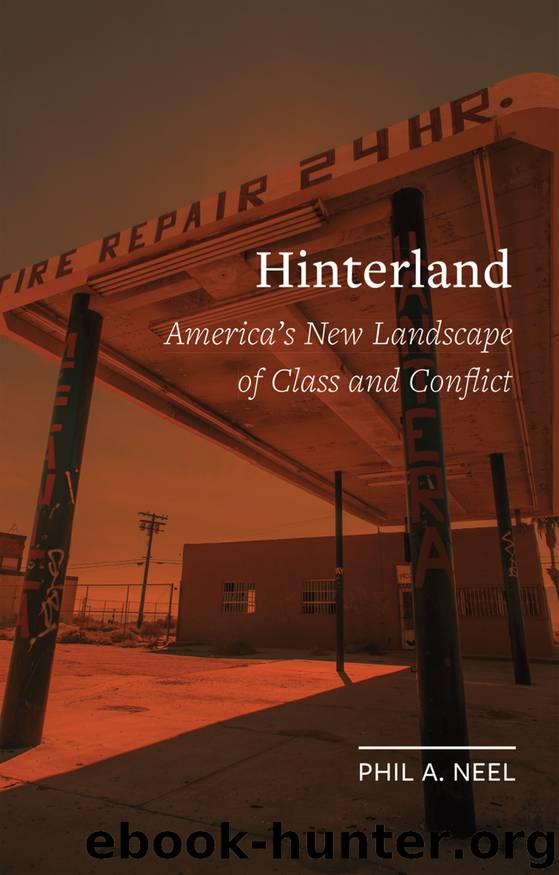Hinterland by Phil A. Neel

Author:Phil A. Neel
Language: eng
Format: epub
Publisher: Reaktion Books
Atmospheres
Seattle is constrained by geology, squeezed between water bodies and constructed along natural sightlines. The glacial history of the region created a landscape in which drumlin ridges run north–south, separated by deep valleys, all artifacts of an ancient climatic shift that devastated the hemisphere and reshaped the very face of the earth. Today, however, it is a climate refuge zone—one of the few parts of the world where the effects of global warming will remain mild in the immediate future.13 This also means that it’s expected to become a sort of catchment for environmental refugees fleeing the destabilizing effects of climate change worldwide. In a certain sense, this is already visible, as new migrants have flooded into the area in the past two decades from all parts of the world, but particularly from areas (such as East Africa and Southeast Asia) already feeling the effects of drought and rising sea levels. Overall, the foreign-born population grew five times faster than the native-born population between 2000 and 2014, composing roughly 21 percent of the total county population.14
My years spent living in the urban core as a food service worker were marked by a series of protests, occupations, riots, and strikes, beginning in 2011 with my involvement in Occupy Seattle and capped in 2014 by several months of incarceration in the county work-release unit on charges related to a riot in 2012. The work-release unit was itself a sort of microcosm of the new Seattle that existed beyond the “revitalized” core. It was organized into a dorm system, with two beds to a cell and twenty or so cells to a dorm, and in it I was living in close quarters with a good demographic cross-section of the city’s poorer districts. The story told by these dorms was one in which out-migration from the urban core and new migrant settlement at the city’s edges has created a demographic shift in the nature of the Seattle area’s segregation. Rather than dividing into majority-white, majority-black, majority-Asian, or majority-Hispanic neighborhoods, the city is segregated roughly into high-income, low-to-moderate-diversity areas in the north and low-income, hyper-diverse areas in the south.15 Most other prisoners were from the south end or the southern suburbs, with little racial sorting by neighborhood, though between one-third and one-half were foreign-born. This type of segregation, is becoming the standard in many cities that have experienced economic booms and in-migration in the first decades of the twenty-first century.
Migration in the U.S. has followed jobs, essentially starting a new cycle of concentrated urbanization in an already heavily urbanized nation.16 Some of the new migrants are working in the still-booming tech and cultural industries of the urban core, but job growth overall has been in low-wage sectors.17 This bifurcates not only the employment profiles of these cities, but their geography. As higher-paid arrivals flood the urban core, rising rents force poorer residents out to the city’s edges and into increasingly impoverished inner ring suburbs. This same dynamic also ensures that new migrants working low-wage jobs will settle in the same areas.
Download
This site does not store any files on its server. We only index and link to content provided by other sites. Please contact the content providers to delete copyright contents if any and email us, we'll remove relevant links or contents immediately.
| Anthropology | Archaeology |
| Philosophy | Politics & Government |
| Social Sciences | Sociology |
| Women's Studies |
Nudge - Improving Decisions about Health, Wealth, and Happiness by Thaler Sunstein(7261)
iGen by Jean M. Twenge(5167)
The Fire Next Time by James Baldwin(5029)
Adulting by Kelly Williams Brown(4243)
The Hacking of the American Mind by Robert H. Lustig(4094)
The Sports Rules Book by Human Kinetics(4081)
The Ethical Slut by Janet W. Hardy(4042)
Captivate by Vanessa Van Edwards(3733)
Mummy Knew by Lisa James(3525)
In a Sunburned Country by Bill Bryson(3376)
The Worm at the Core by Sheldon Solomon(3328)
Ants Among Elephants by Sujatha Gidla(3282)
Suicide: A Study in Sociology by Emile Durkheim(2908)
The Slow Fix: Solve Problems, Work Smarter, and Live Better In a World Addicted to Speed by Carl Honore(2846)
The 48 laws of power by Robert Greene & Joost Elffers(2818)
Humans of New York by Brandon Stanton(2694)
Handbook of Forensic Sociology and Psychology by Stephen J. Morewitz & Mark L. Goldstein(2606)
The Happy Hooker by Xaviera Hollander(2586)
The Tipping Point by Malcolm Gladwell(2566)
